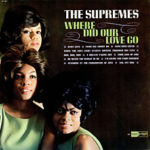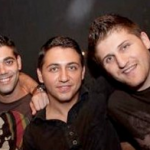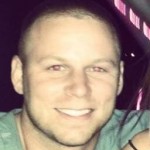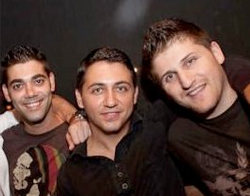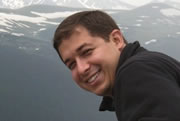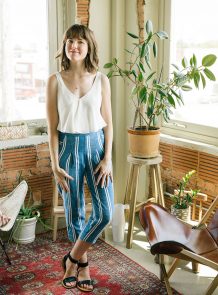 I discovered Kelsey’s photography while researching one of Dallas’s most eclectic and diverse neighborhoods, the Bishop Arts District in Oak Cliff. Kelsey provided much of the photography for the neighborhood website. Kelsey Wilson has a few photographic specialties, one of those is food photography . . . and everyone in Dallas knows there’s lots of food in the Bishop Arts District and good food at that. (For example, check out her Eno’s Pizza Tavern photos here).
I discovered Kelsey’s photography while researching one of Dallas’s most eclectic and diverse neighborhoods, the Bishop Arts District in Oak Cliff. Kelsey provided much of the photography for the neighborhood website. Kelsey Wilson has a few photographic specialties, one of those is food photography . . . and everyone in Dallas knows there’s lots of food in the Bishop Arts District and good food at that. (For example, check out her Eno’s Pizza Tavern photos here).
Kelsey lives in Oak Cliff, not too far from the Bishop Arts District and she frequents its shops and eateries quite regularly. Continue on to read about her business, Kelsey Wilson Photography, the photographer herself, and about some of the fun she has in the Bishop Arts District.
Since I found your work through the Bishop Arts District website, allow me to begin with some questions about this very diverse neighborhood. In your eyes, or through your lens, what makes the Bishop Arts District the special place it is in the Dallas landscape?
I love Oak Cliff (and West Dallas) because they’re both culturally diverse communities. I also love the history of the neighborhoods and architecture. Although gentrification is happening, the neighborhood residents are really trying to keep the rich history alive through restoring old buildings instead of knocking them down (although, sometimes big businesses do win, sadly). I also love the location and the topography complete with old beautiful trees! It’s an inspiring environment for anyone.
You lived for a while in New York City. Is there any neighborhood in New York City which you would favorably compare the Bishop Arts District, either culturally or from a photographic point of view?
I lived in crown heights in 2008. It was in the early stages of changing at that time, but it feels a lot like Oak Cliff to me. I loved the diversity of people, artists, food, etc. Local businesses popping up and people really doing what they love.
Where might someone run into you in the Bishop Arts District on a weeknight and would it be a different place on a weekend?
Haha! I stay away from Bishop Arts on the weekend. Its changed a lot in the last five years, and although the popularity is great for shop owners, the crowded streets and valet parking make it too overwhelming for me. I much prefer areas like Tyler and Davis and the restaurants and businesses on Jefferson Blvd. Cultivar Coffee is right below my studio on Jefferson, so I am definitely there a lot! You also might be able to find me at one of the hundreds of taco stands in the area. I’m a huge fan of tacos. Who isn’t!?
I’m writing these questions after a week full of rain and I wonder what are some places in Dallas that make great outdoor shots in the rain and specifically would anything in the Bishop Arts District make a great photo in a rain shower or a thunderstorm?
So much rain last month!! It makes this gorgeous spring worth it though! I don’t know really what to say about shooting in the rain though. Most of my shooting takes place in a studio, or inside, or we wait for good weather. However, my friends Kelsi and Doug Klembara just opened a natural light photo studio in Tyler Station called The Texas Studio and even if it’s rainy and cloudy the natural light in the space is dreamy! Definitely check it out! Thetexasstudio.com
You’re from Dallas and went to UNT. Where did you grow up in Dallas?
I grew up in Garland right on the edge of Richardson.
How long after college was it before you left to tackle the world in New York City?
I left three weeks after I graduated from UNT! I had spent the summer prior in NYC interning with some photographers and it was one of my favorite summers to date, so I was super excited to move!
Could you describe a week in your life in New York City?
Well I was fresh out of school so I was assisting a lot. I had a couple of clients but I was mostly working with other photographers. So I would help them carry gear, hand them equipment on shots, etc. Nothing is ever consistent when you’re freelance. So there’s really no regularity about your life, but if you can begin to expect the ups and downs then it can become somewhat consistent, if that makes sense. I was also working part time as a telemarketer (not glamorous haha).
Many of us only see life in NYC on TV or in movies, but for a real person, what was it like to shoot there and have a 24/7 urban experience?
Parts of it were amazing and I definitely had those “I can’t believe I live here. This is the best city in the world moments,” but it was also coupled with the “I hate rolling my dirty laundry to the laundromat in a snow storm moments,” too. Assisting photographers was a blast, and getting to see things like the Martha Stewart Prop Room (more like warehouse) are things I’ll never forget. But the economy crashed that fall and budgets got cut, so assisting jobs were harder to get. And I couldn’t take much more of telemarketing (be nice to them btw, they are just doing their job!) Lugging groceries on public transit and having to plan an hour to get anywhere is hard. I don’t think those daily living experiences get portrayed very well on TV.
Thinking back, what was your first camera and what was the impetus for you choosing photography as a career?
My first camera was actually a 110mm film camera called “My First Camera” believe it or not! I had various 35mm cameras as well. I always loved art and really fell in love with photography in high school. It’s rare I think, but I’m thankful I kinda always knew what I wanted to do. Once I settle on something I don’t usually change my mind.
Has one particular photographer been an influence on your own work and chosen career path?
I interned with Anna Wolf and Tara Donne. They are two of the best in the biz and I learned so much from them! They taught me about owning a photography business and commercial and editorial photography. I’m also a big William Eggleston fan.
What technology/software/camera gear do you use today?
I shoot Canon. I prefer Lightroom and Photoshop. I’m not a gear head at all. In fact I really don’t know much about anything when it comes to gear. I know what I have and how to use it well, but when it comes to the latest and greatest I’m usually not the first to know about it. I think studying composition and light are way more important than the technology of photography. And if I don’t know how to use a program or lights I just hire someone who does to be on set.
After a shoot, what is your typical workflow pattern?
This totally depends on the job. If it’s advertising we make selects on set, and those get retouched and given to the client. If it’s editorial I usually give proofs to the client and then they make selections and then I retouch. Sometimes I retouch my own images and sometimes a retoucher does it for me.
What makes a perfect picture and are there any steps you take to ensure you get one?
Hmmm, don’t know if you can ensure anything really…you just try your best! I always try to shoot in varying focal lengths. I think it’s important to get overall scene photos, mid range focal lengths and close ups to tell a good story.
As a key to success in photography, how important would you rate self-confidence?
Any artist is lying if they say they haven’t struggled with insecurity. Everyone is insecure and everyone doubts their ability at some point or another. It’s important to try and be confident, but it’s more important to realize that everyone is in the same boat. My advice would be to stop making yourself look awesome all the time, especially on social media.
As a follow up, what were some points in your career that were real boosts in self-confidence for you?
I guess as I look back and see how I’ve gotten hired by more well known agencies, magazines, and clients. I must be doing something right!
What would you recommend to someone in high school (or even younger) who has the aspiration to be you, a professional commercial photographer?
Just take a lot of photos of everything! Use your phone if you don’t have a camera yet! Observe what light does throughout the day and how it can make the subject look totally different at different times. Study all types of art. Knowing composition and the elements and principles of design is key.
What camera(s) should an aspiring professional photographer purchase?
Hah! I am not a good person to ask because I only know the equipment I have. I would just stress that you don’t have to have top and the line gear to make good photos.
Can you share a few of your favorite food photos here with our readers?*
* editor note: Kelsey was gracious enough to allow me to pick a few of my favorites. Check out her complete collection of food images from her website here and here
Finally, what one thing (or more) makes the woman Kelsey Wilson burst with joy and happiness? Sewing, gardening and tacos!
Thank you so very much for your time Kelsey. You’ve given great insight into what the life of a photographer is like and we now know so much more about you and your love for tacos!
Please check out Kelsey’s photography website right here.
